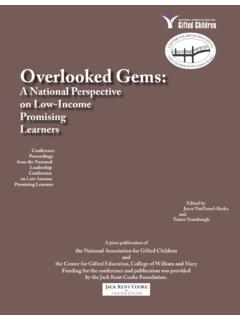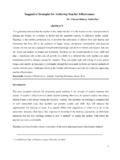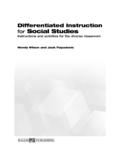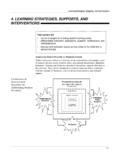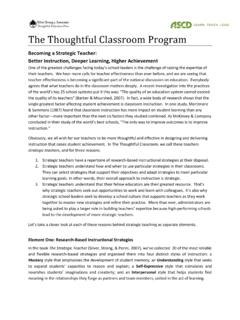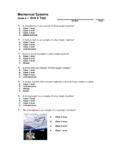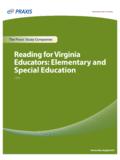Transcription of 1. I routinely differentiate. 2. I occasionally ...
1 4/16/2013.. Julia Link Roberts and Tracy Ford Inman The Center for Gifted Studies at Western Kentucky University 1. I routinely differentiate . 2. I occasionally differentiate . 3. I am thinking about moving to differentiation. 4. I am curious about differentiation. 1. 4/16/2013.. Early in the year . Standard 4: Learning Environments 2. 4/16/2013. Student Outcomes Evidence-Based Practice Personal Competence Educators maintain high expectations for all students with gifts and talents as evidenced Students with gifts and talents in meaningful and challenging activities. demonstrate growth in personal Educators provide opportunities for self- competence and dispositions for exploration, development and pursuit of exceptional academic and creative interests, and development of identities supportive of achievement, , through productivity.
2 These include self- mentors and role models. awareness, self-advocacy, self- Educators create environments that efficacy, confidence, motivation, support trust among diverse learners. resilience, independence, curiosity, Educators provide feedback that focuses and risk taking. on effort, on evidence of potential to meet high standards, and on mistakes as learning opportunities. Educators provide examples of positive coping skills and opportunities to apply them.. Domain 2: Classroom Environment 3. 4/16/2013. A. Creating an Environment of Respect and Rapport i. Teacher Interaction with Students ii. Student Interactions with One Another B. Establishing a Culture for Learning i. Importance of the Content ii.
3 Expectations for Learning and Achievement iii. Student Pride in Work C. Managing Classroom Procedures i. Management of Instructional Groups ii. Management of Transitions iii. Management of Materials and Supplies iv. Performance of Non-Instructional Duties v. Supervision of Volunteers and Paraprofessionals 4. 4/16/2013. D. Managing Student Behavior i. Expectations ii. Monitoring of Student Behavior iii. Response to Student Misbehavior E. Organizing Physical Space i. Safety and Accessibility ii. Arrangement of Furniture and Use of Physical Resources . What is it? What is it not? 5. 4/16/2013. Individual lesson plans A set of strategies Hands-on only A list of choices Additional assignments Not just different Differentiation isn't a fad.
4 Differentiation isn't a trend. Differentiation isn't an invitation. Differentiation is meeting the needs of our students. Differentiation is doing what is best for our students. Differentiation is an expectation.. (Hewitt & Weckstein, 2011, p. 135). 6. 4/16/2013. Differentiation is a philosophy a way of thinking about teaching and learning.. (Tomlinson & Imbeau, 2010, p. 13). Differentiated instruction is a proactively planned, interdependent system marked by a positive community of learners, focused high-quality curriculum, ongoing assessment, flexible instructional arrangements, [and] respectful tasks.. (Beasley, 2009, slide 2). 7. 4/16/2013. The match of the curriculum and learning experiences to learners.
5 A teacher who differentiates effectively matches the content (basic to complex), the level of the thinking process, the sophistication and choice of the product, and/or the assessment to the student or cluster of students.. (Roberts & Inman, 2013, ).. Is the culture right for differentiation? 8. 4/16/2013. A mentality Need to finish first Need to be right the first time Fixed mindset Sense of fairness Owning the myths 9. 4/16/2013. Varied levels of readiness and ability, varied interests, and varied learning profiles Need for complexity and challenge Need for idea-mates . 10. 4/16/2013. May appear disorganized and noisy, but, on closer examination, a strong organizational structure is evident How do I organize materials and resources?
6 What are different grouping possibilities? How can students get into groups smoothly? How do I get multiple learning experiences started at the same time? How do I know when groups need to change? What do I do with students who finish early? students who need more time? How do I monitor progress? 11. 4/16/2013. The key is to practice procedures and routines early in the school year and often. 12. 4/16/2013. May appear disorganized and noisy, but, on closer examination, a strong organizational structure is evident Variety of resources on range of Lexile/reading levels Whole class discussing one concept via different learning perspectives Variety of products both on display and being created Students have access to anchor activities whether physical or electronic Routine formative assessment, including preassessment Students actively engaged in learning Small group, individual, and whole group learning Continuous progress.
7 Everyone learns Community of learners Minds-on learning that may be supplemented by hands-on learning Appropriately challenging learning experiences Learning experiences that center on a concept or topic that may be approached from different perspectives based on interests and readiness Risk-taking: stretching to learn at higher levels Respectful learning experiences Opportunities to use strengths and interests in both learning and demonstrating learning ( , products). 13. 4/16/2013.. How do they differ? Traditional Differentiated Fixed physical environment Flexible environment Grade-level resources Variety of levels of resources Same assignments with Different assignments that same amount of time take pace into consideration Teacher-led instruction Teacher as facilitator or coach Same starting place for all Preassessment makes match Same summative Varying assessments match assessment for all learning experiences 14.
8 4/16/2013.. Lack of time Limited resources Management issues Lack of training both in learning strategies and classroom management No role modeling Nation- or state-wide emphasis on content mastery for state assessments 15. 4/16/2013. Children are different Continuous progress is the reason to go to school Motivates learners Appropriately challenging material encourages development of life skills ( , organizational skills, time-management, risk-taking, sense of responsibility, work ethic, etc.). Develops metacognition and autonomous learning Reasons Reasons teachers teachers do not differentiate are differentiate are student-based. teacher-based. 16. 4/16/2013.. 17. 4/16/2013. Climate and Culture o Diversity o Challenge o High expectations o Risk-taking o Instruction through assessment o Instruction through procedures and routines o A community of learners o Excellence in teaching Learner Outcomes What do I want students to know, understand, or to be able Planning to do?
9 Who already knows and understands the information and/or can do it? Who needs additional support in order to Preassessment know, understand, and/or demonstrate the skills? What can I do for him, her, or them so they can make Differentiation continuous progress and extend their learning? 18. 4/16/2013. Instructional dimensions o Teachers can differentiate . Content Process Product Assessment What do you What do you How can How do you want the want the students assess what students to students to demonstrate has been know? do what they've learned? cognitively learned? with what they know? Differentiation strategies o The topic for next week's webinar. 19. 4/16/2013.. 20.


